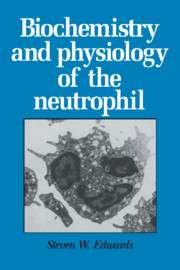Book contents
- Frontmatter
- Contents
- Abbreviations
- Preface
- 1 Neutrophils and host defence: The fight against infection
- 2 The development and structure of mature neutrophils
- 3 The generation and recognition of neutrophil-activating factors: Structure and function of neutrophil receptors
- 4 The cytoskeleton: The molecular framework regulating cell shape and the traffic of intracellular components
- 5 The respiratory burst: The generation of reactive oxygen metabolites and their role in microbial killing
- 6 Neutrophil activation: The production of intracellular signalling molecules
- 7 Neutrophil priming: Regulation of neutrophil function during inflammatory activation
- 8 Disorders of neutrophil function
- Index
4 - The cytoskeleton: The molecular framework regulating cell shape and the traffic of intracellular components
Published online by Cambridge University Press: 26 February 2010
- Frontmatter
- Contents
- Abbreviations
- Preface
- 1 Neutrophils and host defence: The fight against infection
- 2 The development and structure of mature neutrophils
- 3 The generation and recognition of neutrophil-activating factors: Structure and function of neutrophil receptors
- 4 The cytoskeleton: The molecular framework regulating cell shape and the traffic of intracellular components
- 5 The respiratory burst: The generation of reactive oxygen metabolites and their role in microbial killing
- 6 Neutrophil activation: The production of intracellular signalling molecules
- 7 Neutrophil priming: Regulation of neutrophil function during inflammatory activation
- 8 Disorders of neutrophil function
- Index
Summary
The cytoplasm of the neutrophil is highly structured and is organised into four distinct components that constitute the fibrillar meshwork: the microfilaments, microtubules, intermediate filaments and the microtrabecular lattice. These components form the cytoskeleton, the supporting framework for the cell, within which the intracellular components are embedded. Thus, the translocation of cytoplasmic organelles and granules, the movement of cytosolic proteins, the recycling of receptors – as well as key neutrophil functions such as cell movement, phagocytosis, NADPH oxidase activation, degranulation and receptor regulation – are all intimately associated with changes in the organisation of the cytoskeleton. Therefore, in order for the neutrophil to be able to mount the appropriate response upon exposure to stimuli, plasma membrane occupancy must be linked to changes in cytoskeletal organisation via the generation of second messengers. Furthermore, because activation of some neutrophil functions or changes in morphology may be observed within seconds of an agonist binding to its receptor, the cytoskeleton must be capable of responding very rapidly to the production of such second-messenger molecules. It is also now becoming accepted that cytoskeletal reorganisations may also terminate some responses – as in the termination of second-messenger production by interaction of cytoskeletal elements with receptors to down-regulate their function, or by receptor internalisation. Thus, the cytoskeleton is a highly-complex network comprising numerous proteins, and these respond to second messengers to undergo rapid changes in molecular reorganisation upon appropriate stimulation.
Information
- Type
- Chapter
- Information
- Biochemistry and Physiology of the Neutrophil , pp. 128 - 148Publisher: Cambridge University PressPrint publication year: 1994
Accessibility standard: Unknown
- 1
- Cited by
